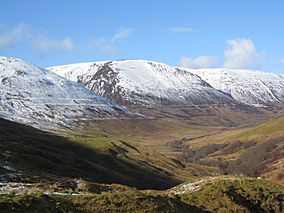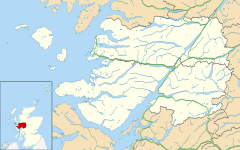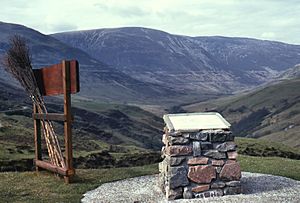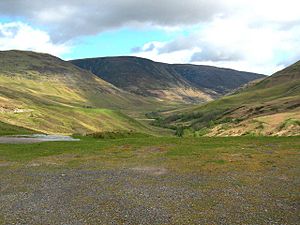Glen Roy facts for kids
Quick facts for kids Glen Roy National Nature Reserve |
|
|---|---|
|
IUCN Category III (Natural Monument)
|
|

The Parallel Roads of Glen Roy, highlighted by recent snowfall
|
|
| Location | Roybridge, Lochaber, Scotland |
| Area | 1,168.3 ha (4.511 sq mi) |
| Established | 1970 |
| Governing body | NatureScot |
| Glen Roy National Nature Reserve | |
Glen Roy (which means "red glen" in Scottish Gaelic) is a special valley in the Lochaber area of the Highlands of Scotland. It's famous for a cool natural wonder: three flat lines, like giant steps, running along its hillsides. These are known as the Parallel Roads of Glen Roy.
These "roads" aren't man-made at all! They were actually the shorelines of a huge, ancient lake. This lake was formed by a wall of ice during a very cold time after the last big ice age. From far away, they really do look like roads built by people. Today, much of Glen Roy is a protected area called a National Nature Reserve.
Glen Roy stretches north from Glen Spean. The main A86 road and the West Highland Line railway pass through Glen Spean. The village of Roybridge is where the River Roy meets the River Spean. From there, a small road goes almost 16 kilometers (10 miles) up the glen.
The Parallel Roads: Nature's Mystery
The Parallel Roads of Glen Roy are truly amazing. They are old shorelines from a huge lake that was blocked by ice. This happened during a very cold period called the Younger Dryas. Imagine a giant ice dam holding back a massive lake in the valley!
As the climate changed, the ice dam would sometimes melt a little. This caused the lake's water level to drop. Each time the water level stayed the same for a while, it carved a new shoreline into the hillside. Over time, this created the three distinct "roads" we see today. They show us how the ancient lake shrank as the ice melted away.
Scientists Study the Roads
For a long time, scientists were very curious about the Parallel Roads. In the 1800s, many famous geologists came to study them. They included people like William Buckland and Charles Lyell. This interest helped geology become a more important science.
One famous visitor was Charles Darwin, who came in 1838. He had just returned from his Beagle trip around the world. Based on what he saw in South America, Darwin thought the Parallel Roads were old sea beaches that had been lifted up. He wrote a paper about his idea.
But then, in 1840, another scientist named Louis Agassiz came up with a different idea. He suggested that huge glaciers had once covered much of the Earth. Agassiz believed the Glen Roy lines were made by ice and a lake, not the sea. This was part of his new "Glacial Theory."
Darwin defended his sea-beach idea for many years. But in 1861, a scientist named Thomas Jamieson visited Glen Roy. He carefully studied the area. After his visit, Jamieson wrote to Darwin, sharing his findings. Darwin was convinced! He admitted his earlier idea was a "gigantic blunder." This shows how science works: new evidence can change even the most famous scientists' minds.
People are still fascinated by the Parallel Roads today. Scientists continue to study them to learn more about Earth's past. Tourists also love to visit and see this incredible natural wonder.
Protecting Glen Roy
Glen Roy is a very special place, so it has several protections. It was made a National Nature Reserve (NNR) in 1970. This means it's a protected area managed by NatureScot. They work to keep the natural environment safe.
Glen Roy is also a Site of Special Scientific Interest (SSSI). This is another way to protect important natural places in Scotland. These protections help make sure the Parallel Roads and the beautiful glen are preserved for everyone to enjoy. It's also part of the Lochaber Geopark, which highlights its important geology.






